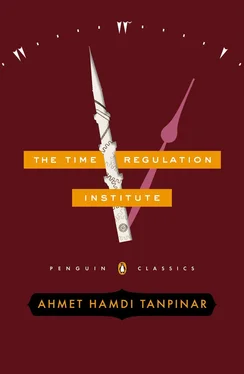But still professional architects rejected my work out of hand. Such was their opposition that we had difficulty finding anyone willing to oversee construction or do so much as calculate the required amount of reinforced concrete.
As I mentioned earlier, I was very much indebted to Dr. Mussak, be it for his modeling techniques or the matter of my stairs. I’d now like to pay tribute once more to this dear friend of mine, a kindred spirit; indeed I never could understand why he’d not been born in our part of the world. Surely he would congratulate me when the building was finished. He would have been proud to see the way I avenged myself against those who refused to see daydreaming as a virtue. Indeed I felt I was atoning for him, with every round of applause I received. I was more than willing to share with him the bonuses I received from the Timely Banks and the institute for my work on the new building.
So how strange it was, when it came time to begin work on our Clock Houses, and Halit Ayarcı suggested I should draw up the plans for our residential neighborhoods; despite my brilliant success with the institute building, he could not find a single friend, even among those who had formerly admired my work, who thought I was the man for the job. Even our closest friends, who for months had claimed the institute to be the pinnacle of innovation, who had seemed so very pleased with it, who had come, if not every day then at least once or twice a week, to watch the new building go up, these dear friends of mine who had dropped by on the way home to push and shove outside my office door, just to offer me their congratulations — they all protested. The most levelheaded of them cried:
“These are private homes that we’ll leave to our children! There’s no need for any originality! Just let them be well built, affordable, and safe!”
Some of them went even further, shouting:
“We’re not about to experiment with our hard-earned wages. We want a home, not a clever work of art!”
Even Dr. Ramiz, who knew me so very well, was of the same opinion.
“Impossible, my dear friend, impossible!” he ejaculated. “Who knows, you might just place the stairs on the wrong side of the house! It’s simply out of the question.”
As best I could, I explained to Dr. Ramiz that he himself had been more than a bit responsible for a floor inaccessible by stairs, and that my original inspiration for such a design had in fact been his description of the human mind. But my every attempt brought the answer:
“Don’t confuse such things, my dear friend! A house is one thing — science and the subconscious quite another!”
Lazybones Asaf was the only one who kept his opinion to himself. With his fly swatter in hand — it was toward the end of summer and our friend had got in the habit of hunting flies — he sat through three meetings without understanding much at all, but during the fourth he came over to me and whispered:
“My dear friend Hayri, it’s best you just drop it. There’s a house I’ve inherited from my father, if you like I can have it fixed up and then give it to you! You can satisfy your curiosity there!”
My wife agreed. Though Pakize had posed for thirty-five photographs beside the matchbox model, she nearly lost her head when she heard that I might be designing our home. For the first time ever, my wife, my daughter, and my son-in-law were all of the same mind. My wife kept saying, “God forbid! Could anyone actually live in one of your houses?” while Zehra used all her womanly charms to convince me to give up the idea.
Truth be told, I really had no desire to design the Clock Houses. My interest — and frankly, my passion — was with the human soul. Were other people like me, or were they just a bit different? I was determined to find the answer. Surely they were like me, or even worse. Clearly they were self-centered. When public funds were involved, they were generous, enthusiastic, proud of my work, and enthralled by its innovation, but when it touched on their personal interests, they flipped sides. Indeed they even stopped listening to Halit Ayarcı.
“But please, you can only joke around with people up to a certain point.” That was the common refrain. All in all, people showed their true colors. In this aspect at least they all seemed the same. Halit Ayarcı was really quite distraught and didn’t have the slightest idea what to do; every now and then he came to me and complained.
“How is this possible?” he cried. “Here we have people who work in the world’s most modern institute, steeped in innovations, and in conditions they acknowledge to be the best and most advanced in the world — how could they not understand this? If they do not understand, then for goodness sake, what are they doing at the institute? Why did they applaud the new building? Why did they congratulate us? Nothing but lies!”
I tried to explain the situation to Halit Ayarcı.
“No, they weren’t lying,” I said. “They were sincere on both occasions. They adore innovation providing it doesn’t affect them personally. And they continue to adore it but with this one condition. In their personal lives they prefer to be safe and secure.”
“How can that be? Can a human being think about something in two entirely different ways? Can two different sets of logic coexist in their heads?”
Halit Ayarcı was truly in despair.
“Of course. Or, better said, when personal interests shift, logic follows suit.”
“Truth is, I just cannot comprehend such a thing! All my life’s work has collapsed before me. This institute is no longer mine!”
Beads of sweat ran down his temples. I’d never seen him in such a state. He had held his own against much stronger and more powerful opposition. But now just a handful of people — people he himself had created — had taken him by surprise. He looked vacantly about the room.
“Have you ever been to a boxing match?” I asked. “At first we can’t even bear to watch. Then soon enough we get excited and side with one of the boxers. Not long after that we’re angry that he’s not holding up well enough, and we scream at the top of our lungs: ‘Come on! Hit him harder! That’s the way!’ And if he doesn’t, we feel disappointed. But which one of us actually wants to be in that fighter’s shoes? No one, right? These people are no different. They watched us fight and cheered us on and even applauded our efforts. And they meant it. But now that you’ve welcomed them into the ring, it’s all changed. Now it’s a matter of their personal interest and safety!”
“Then these people don’t believe in me! We’ve banded together here for nothing! We have struggled in vain!”
“No, they still believe in you, providing their personal needs remain untouched. Besides, why do you need them to believe in you? This I don’t understand…”
“But work is work!”
And so it was that the long and difficult discussions over the Clock Houses chewed up Halit Ayarcı from the inside out.
The fourth meeting was the most arduous. Halit Ayarcı went so far as to issue threats. Alas! The magic had worn off. The opposition was just too strong. They didn’t even give him a chance to speak. The Clock Houses would be just like any other houses. That was the majority’s final word.
He left the meeting early, ceding his seat to me. For the first time, I exercised my right to vote and, having succumbed to the majority, I left.
When I went into his office, I found myself with an entirely changed Halit Ayarcı. Sitting in the chair he had once pulled out for my aunt, he had his feet up on the table and was deep in thought. When he saw me come in, he said:
“Somewhere I went wrong… But where? Where did I go wrong? If I could just figure this out I’d feel so much better…”
Читать дальше












